Kawon Han
Sensing-Secure ISAC: Ambiguity Function Engineering for Impairing Unauthorized Sensing
Oct 02, 2025Abstract:The deployment of integrated sensing and communication (ISAC) brings along unprecedented vulnerabilities to authorized sensing, necessitating the development of secure solutions. Sensing parameters are embedded within the target-reflected signal leaked to unauthorized passive radar sensing eavesdroppers (Eve), implying that they can silently extract sensory information without prior knowledge of the information data. To overcome this limitation, we propose a sensing-secure ISAC framework that ensures secure target detection and estimation for the legitimate system, while obfuscating unauthorized sensing without requiring any prior knowledge of Eve. By introducing artificial imperfections into the ambiguity function (AF) of ISAC signals, we introduce artificial targets into Eve's range profile which increase its range estimation ambiguity. In contrast, the legitimate sensing receiver (Alice) can suppress these AF artifacts using mismatched filtering, albeit at the expense of signal-to-noise ratio (SNR) loss. Employing an OFDM signal, a structured subcarrier power allocation scheme is designed to shape the secure autocorrelation function (ACF), inserting periodic peaks to mislead Eve's range estimation and degrade target detection performance. To quantify the sensing security, we introduce peak sidelobe level (PSL) and integrated sidelobe level (ISL) as key performance metrics. Then, we analyze the three-way trade-offs between communication, legitimate sensing, and sensing security, highlighting the impact of the proposed sensing-secure ISAC signaling on system performance. We formulate a convex optimization problem to maximize ISAC performance while guaranteeing a certain sensing security level. Numerical results validate the effectiveness of the proposed sensing-secure ISAC signaling, demonstrating its ability to degrade Eve's target estimation while preserving Alice's performance.
Network-Level ISAC Design: State-of-the-Art, Challenges, and Opportunities
May 02, 2025



Abstract:The ultimate goal of integrated sensing and communication (ISAC) deployment is to provide coordinated sensing and communication services at an unprecedented scale. This paper presents a comprehensive overview of network-level ISAC systems, an emerging paradigm that significantly extends the capabilities of link-level ISAC through distributed cooperation. We first examine recent advancements in network-level ISAC architectures, emphasizing various cooperation schemes and distributed system designs. The sensing and communication (S\&C) performance is analyzed with respect to interference management and cooperative S\&C, offering new insights into the design principles necessary for large-scale networked ISAC deployments. In addition, distributed signaling strategies across different levels of cooperation are reviewed, focusing on key performance metrics such as sensing accuracy and communication quality-of-service (QoS). Next, we explore the key challenges for practical deployment where the critical role of synchronization is also discussed, highlighting advanced over-the-air synchronization techniques specifically tailored for bi-static and distributed ISAC systems. Finally, open challenges and future research directions in network-level ISAC design are identified. The findings and discussions aim to serve as a foundational guideline for advancing scalable, high-performance, and resilient distributed ISAC systems in next-generation wireless networks.
Over-the-Air Time-Frequency Synchronization in Distributed ISAC Systems
Mar 11, 2025Abstract:A distributed integrated sensing and communication (D-ISAC) system offers significant cooperative gains for both sensing and communication performance. These gains, however, can only be fully realized when the distributed nodes are perfectly synchronized, which is a challenge that remains largely unaddressed in current ISAC research. In this paper, we propose an over-the-air time-frequency synchronization framework for the D-ISAC system, leveraging the reciprocity of bistatic sensing channels. This approach overcomes the impractical dependency of traditional methods on a direct line-of-sight (LoS) link, enabling the estimation of time offset (TO) and carrier frequency offset (CFO) between two ISAC nodes even in non-LoS (NLOS) scenarios. To achieve this, we introduce a bistatic signal matching (BSM) technique with delay-Doppler decoupling, which exploits offset reciprocity (OR) in bistatic observations. This method compresses multiple sensing links into a single offset for estimation. We further present off-grid super-resolution estimators for TO and CFO, including the maximum likelihood estimator (MLE) and the matrix pencil (MP) method, combined with BSM processing. These estimators provide accurate offset estimation compared to spectral cross-correlation techniques. Also, we extend the pairwise synchronization leveraging OR between two nodes to the synchronization of $N$ multiple distributed nodes, referred to as centralized pairwise synchronization. We analyze the Cramer-Rao bounds (CRBs) for TO and CFO estimates and evaluate the impact of D-ISAC synchronization on the bottom-line target localization performance. Simulation results validate the effectiveness of the proposed algorithm, confirm the theoretical analysis, and demonstrate that the proposed synchronization approach can recover up to 96% of the bottom-line target localization performance of the fully-synchronous D-ISAC.
Signaling Design for Noncoherent Distributed Integrated Sensing and Communication Systems
Jan 30, 2025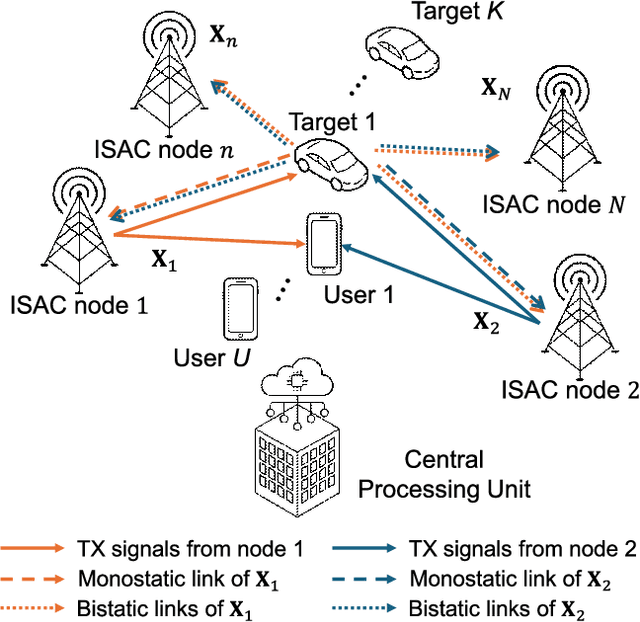
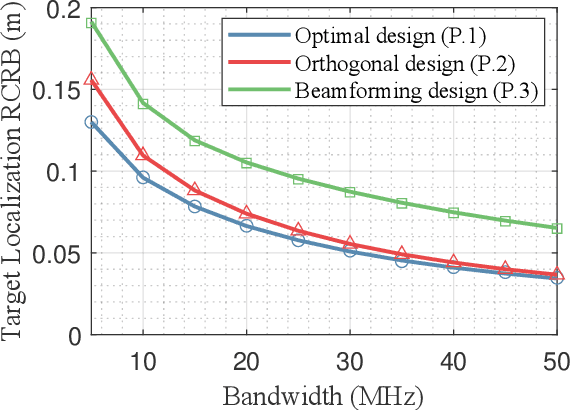
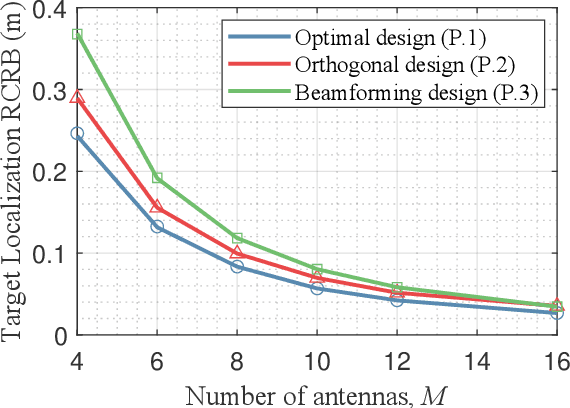
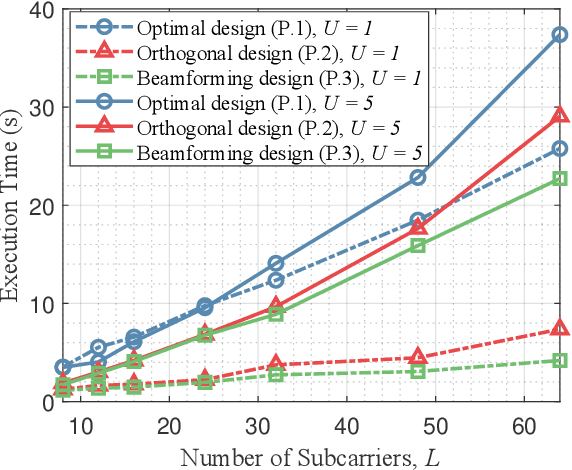
Abstract:The ultimate goal of enabling sensing through the cellular network is to obtain coordinated sensing of an unprecedented scale, through distributed integrated sensing and communication (D-ISAC). This, however, introduces challenges related to synchronization and demands new transmission methodologies. In this paper, we propose a transmit signal design framework for D-ISAC systems, where multiple ISAC nodes cooperatively perform sensing and communication without requiring phase-level synchronization. The proposed framework employing orthogonal frequency division multiplexing (OFDM) jointly designs downlink coordinated multi-point (CoMP) communication signals and multi-input multi-output (MIMO) radar signals, leveraging both collocated and distributed MIMO radars to estimate angle-of-arrival (AOA) and time-of-flight (TOF) from all possible multi-static measurements for target localization. To design the optimal D-ISAC transmit signal, we use the target localization Cram\'er-Rao bound (CRB) as the sensing performance metric and the signal-to-interference-plus-noise ratio (SINR) as the communication performance metric. Then, an optimization problem is formulated to minimize the localization CRB while maintaining a minimum SINR requirement for each communication user. Moreover, we present three distinct transmit signal design approaches, including optimal, orthogonal, and beamforming designs, which reveal trade-offs between ISAC performance and computational complexity. Unlike single-node ISAC systems, the proposed D-ISAC designs involve per-subcarrier sensing signal optimization to enable accurate TOF estimation, which contributes to the target localization performance. Numerical simulations demonstrate the effectiveness of the proposed designs in achieving flexible ISAC trade-offs and efficient D-ISAC signal transmission.
Network-level ISAC: Performance Analysis and Optimal Antenna-to-BS Allocation
Oct 08, 2024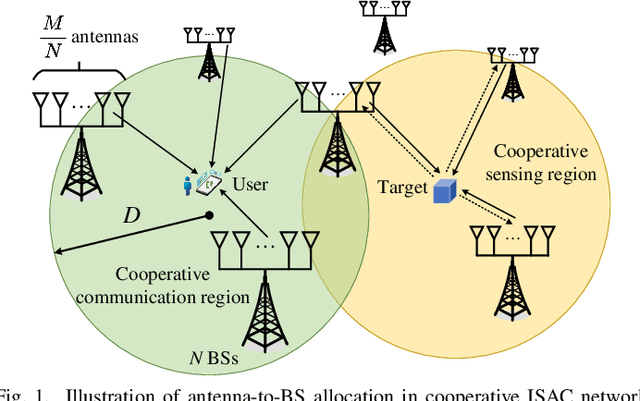
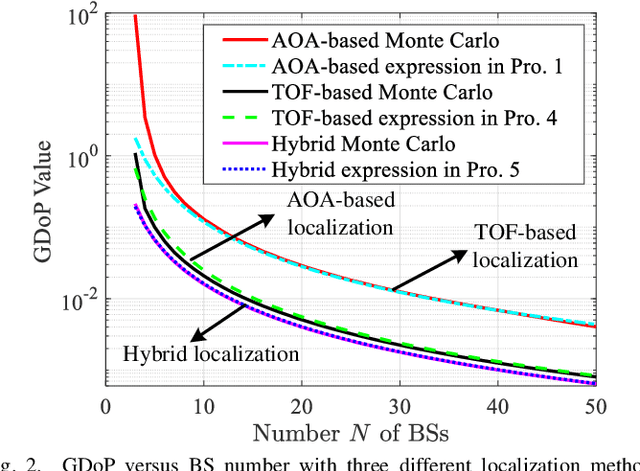
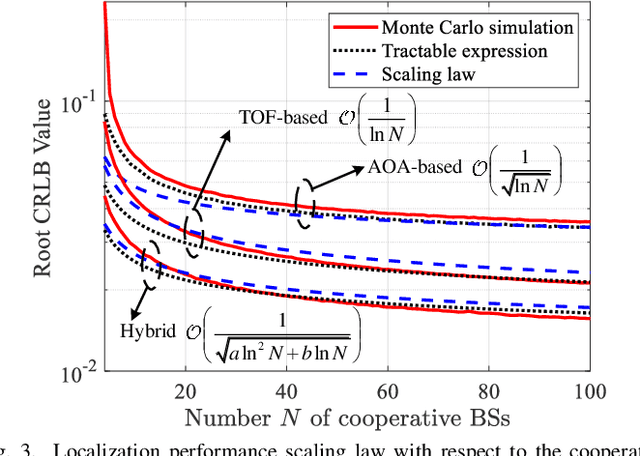
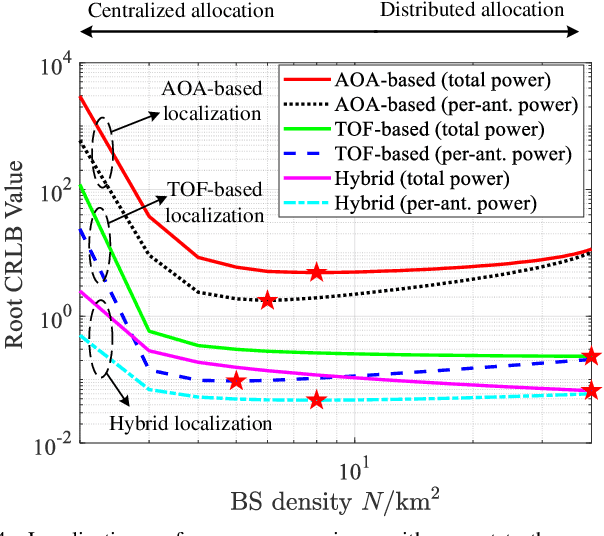
Abstract:A cooperative architecture is proposed for integrated sensing and communication (ISAC) networks, incorporating coordinated multi-point (CoMP) transmission along with multi-static sensing. We investigate how the allocation of antennas-to-base stations (BSs) affects cooperative sensing and cooperative communication performance. More explicitly, we balance the benefits of geographically concentrated antennas, which enhance beamforming and coherent processing, against those of geographically distributed antennas, which improve diversity and reduce service distances. Regarding sensing performance, we investigate three localization methods: angle-of-arrival (AOA)-based, time-of-flight (TOF)-based, and a hybrid approach combining both AOA and TOF measurements, for critically appraising their effects on ISAC network performance. Our analysis shows that in networks having N ISAC nodes following a Poisson point process, the localization accuracy of TOF-based methods follow a \ln^2 N scaling law (explicitly, the Cram\'er-Rao lower bound (CRLB) reduces with \ln^2 N). The AOA-based methods follow a \ln N scaling law, while the hybrid methods scale as a\ln^2 N + b\ln N, where a and b represent parameters related to TOF and AOA measurements, respectively. The difference between these scaling laws arises from the distinct ways in which measurement results are converted into the target location. In terms of communication performance, we derive a tractable expression for the communication data rate, considering various cooperative region sizes and antenna-to-BS allocation strategy. It is proved that higher path loss exponents favor distributed antenna allocation to reduce access distances, while lower exponents favor centralized antenna allocation to maximize beamforming gain.
Sub-Nyquist Sampling OFDM Radar With a Time-Frequency Phase-Coded Waveform
Mar 21, 2024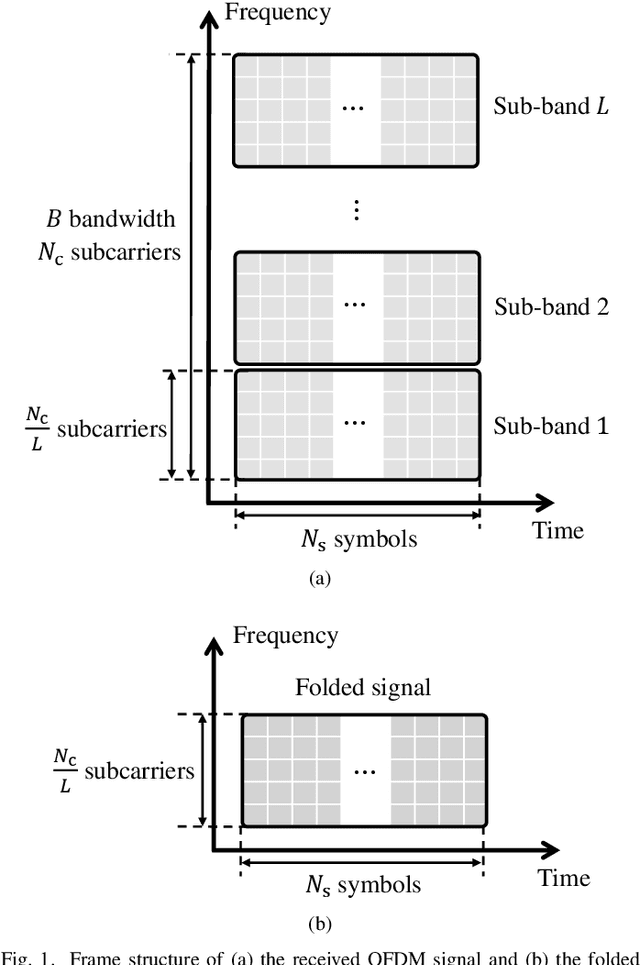
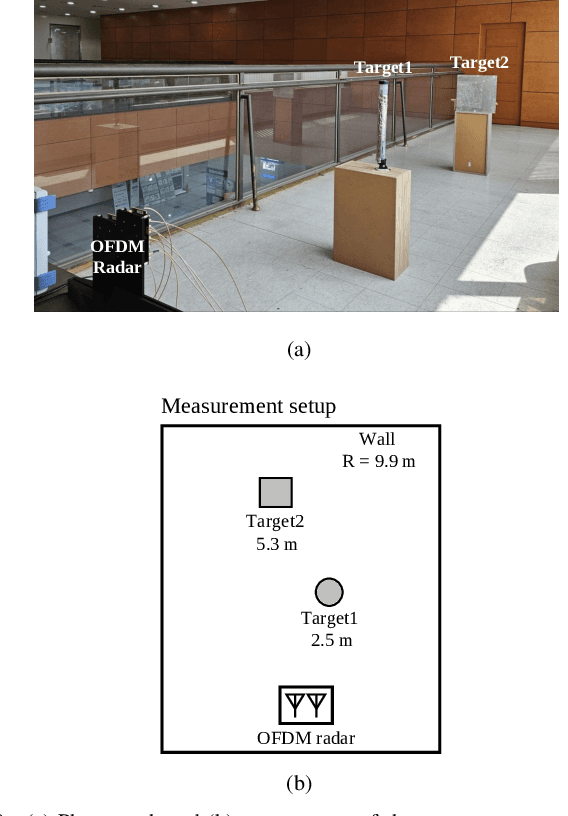
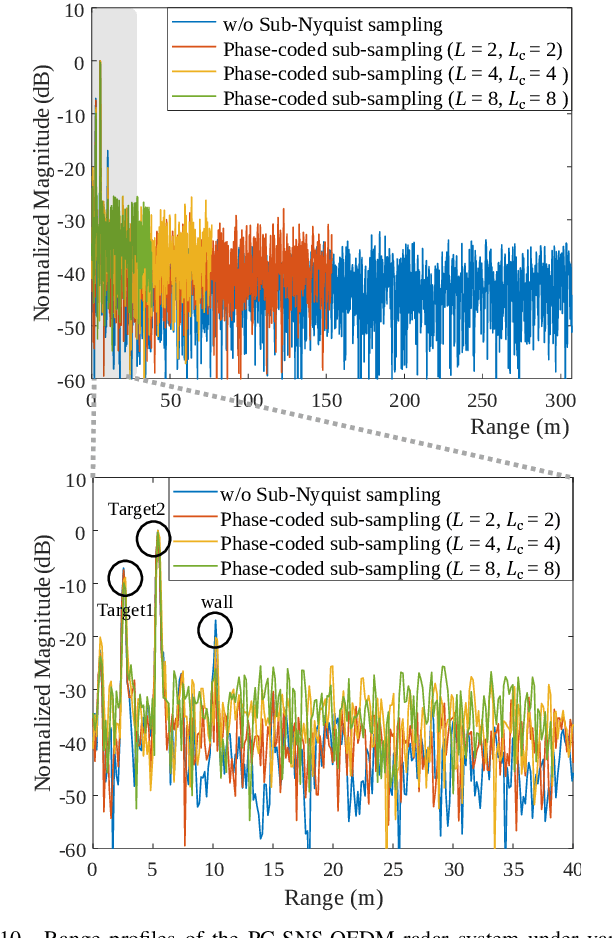
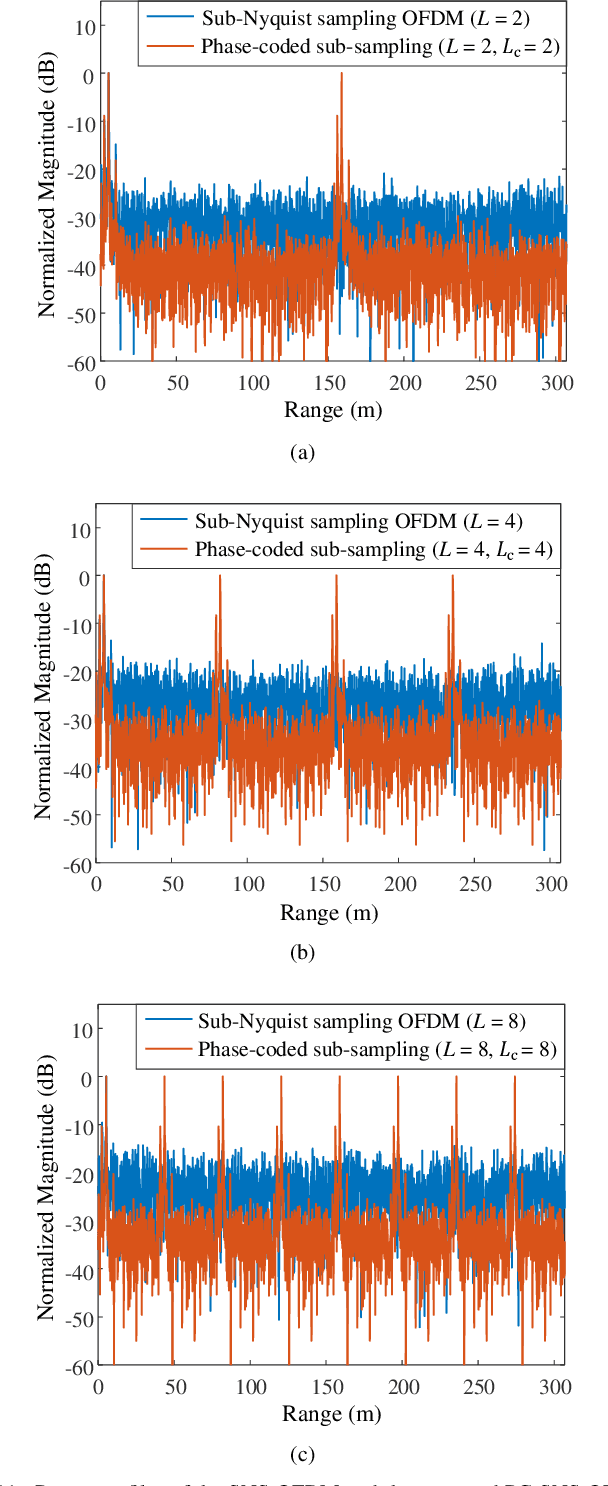
Abstract:This paper presents a time-frequency phase-coded sub-Nyquist sampling orthogonal frequency division multiplexing (PC-SNS-OFDM) radar system to reduce the analog-to-digital converter (ADC) sampling rate without any additional hardware or signal processing. The proposed radar divides the transmitted OFDM signal into multiple sub-bands along the frequency axis and provides orthogonality to these sub-bands by multiplying phase codes in both the time and frequency domains. Although the sampling rate is reduced by the factor of the number of sub-bands, the sub-bands above the sampling rate are folded into the lowest one due to aliasing. In the process of restoring the signals in folded sub-bands to those in full signal bands, the proposed PC-SNS-OFDM radar effectively eliminates symbol-mismatch noise while introducing trade-offs in the range and Doppler ambiguities. The utilization of phase codes in both the frequency and time domains provides flexible control of the range and Doppler ambiguities. It also improves the signal-to-noise ratio (SNR) of detected targets compared to an earlier sub-Nyquist sampling OFDM radar system. This is validated with simulations and experiments under various sub-Nyquist sampling rates.
Sub-Nyquist Sampling OFDM Radar
Aug 03, 2023
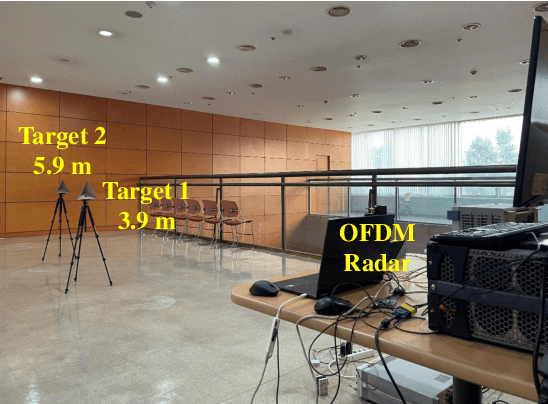
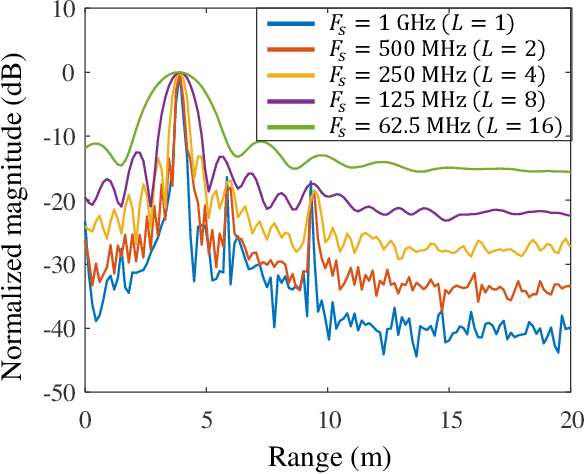
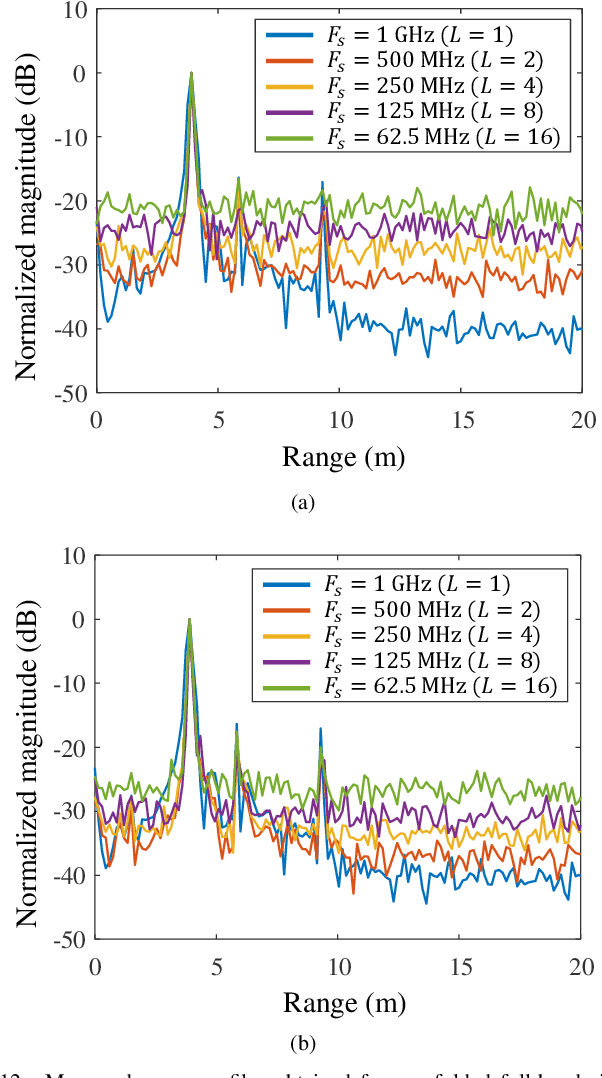
Abstract:In this paper, we propose a sub-Nyquist sampling (SNS) orthogonal frequency-division multiplexing (OFDM) radar system capable of reducing the analog-to-digital converter (ADC) sampling rate in OFDM radar without any additional manipulations of its hardware and waveform. To this end, the proposed system utilizes the ADC sampling rate of B/L to sample the received baseband signal with a bandwidth of B, where L is a positive proper divisor of the number of subcarriers. This divides the baseband signal into L sub-bands, folding into a sub-Nyquist frequency band due to aliasing. By leveraging known modulation symbols of the transmitted signal, the folded signal can be unfolded to the full-band signal. This allows an estimation of target ranges with the range resolution of the full signal bandwidth B without the degradation of the maximum unambiguous range. During the signal-unfolding process, the signals from other sub-bands remain as symbol-mismatch noise (SMN), which significantly degrades the signal-to-noise ratio (SNR) of the detected targets. It also causes weaker targets to be submerged under the noise in range profiles. To resolve this, a symbol-mismatch noise cancellation (SMNC) technique is also proposed, which reconstructs the interfering signals from the other sub-bands using the detected targets and subtracts them from the unfolded signal. As a result, the proposed sub-Nyquist sampling OFDM radar and corresponding signal processing technique enable a reduction in the ADC sampling rate by the ratio of L while incurring only a 10 log10 L increase in the noise due to noise folding. This is validated through simulations and measurements with various sub-sampling ratios.
ORORA: Outlier-Robust Radar Odometry
Mar 03, 2023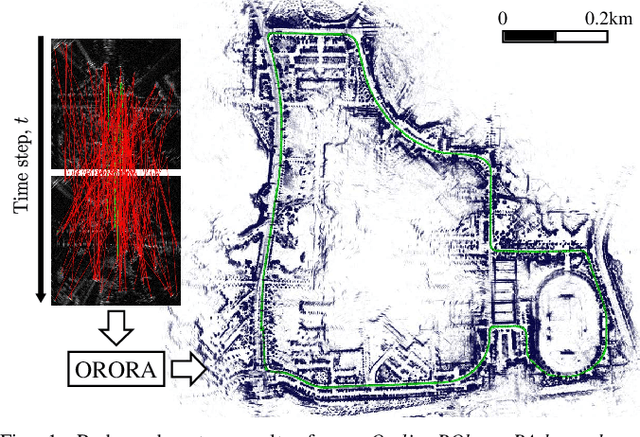

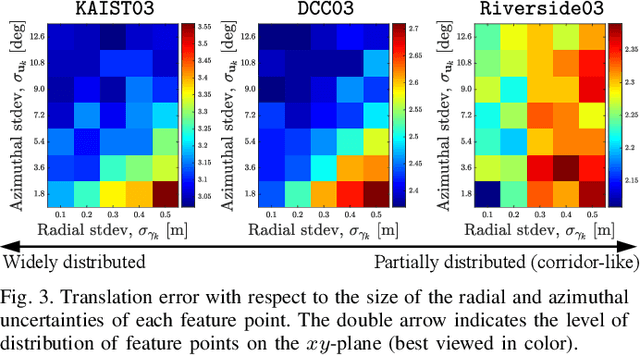
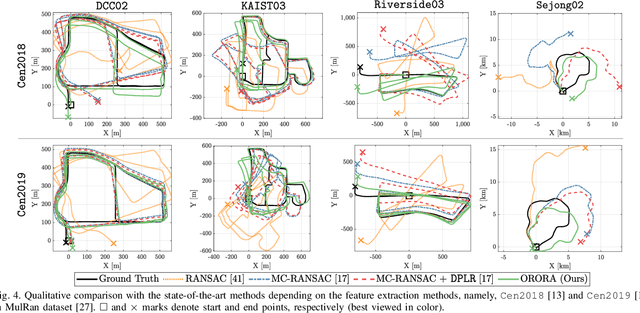
Abstract:Radar sensors are emerging as solutions for perceiving surroundings and estimating ego-motion in extreme weather conditions. Unfortunately, radar measurements are noisy and suffer from mutual interference, which degrades the performance of feature extraction and matching, triggering imprecise matching pairs, which are referred to as outliers. To tackle the effect of outliers on radar odometry, a novel outlier-robust method called \textit{ORORA} is proposed, which is an abbreviation of \textit{Outlier-RObust RAdar odometry}. To this end, a novel decoupling-based method is proposed, which consists of graduated non-convexity~(GNC)-based rotation estimation and anisotropic component-wise translation estimation~(A-COTE). Furthermore, our method leverages the anisotropic characteristics of radar measurements, each of whose uncertainty along the azimuthal direction is somewhat larger than that along the radial direction. As verified in the public dataset, it was demonstrated that our proposed method yields robust ego-motion estimation performance compared with other state-of-the-art methods. Our code is available at https://github.com/url-kaist/outlier-robust-radar-odometry.
 Add to Chrome
Add to Chrome Add to Firefox
Add to Firefox Add to Edge
Add to Edge